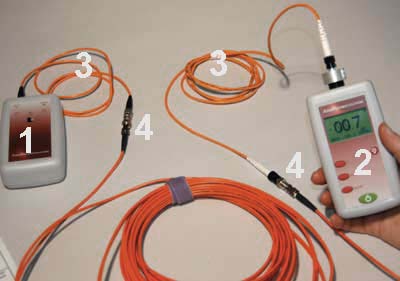Cutting-Edge OFDA Solutions for Accurate Fibre Analysis and Testing
Cutting-Edge OFDA Solutions for Accurate Fibre Analysis and Testing
Blog Article
Necessary Attributes to Seek in Optical Fiber Testing Devices
When evaluating optical fiber testing tools, a number of necessary functions necessitate cautious factor to consider to make sure optimal performance and integrity. Compatibility with existing market requirements enhances capability, while advanced dimension capabilities, consisting of TDR and OTDR screening, offer critical insights right into network integrity. Understanding these functions will certainly drop light on just how to choose the ideal tools for your particular demands.
Precision and Accuracy
Accuracy and precision are essential parameters in the examination of optical fiber testing devices. These 2 qualities ensure that measurements show real performance of fibre optic systems, which is important for reliable network installment, upkeep, and troubleshooting. Precision describes the closeness of a determined value to the real worth, while accuracy denotes the repeatability of measurements under the same problems.
When selecting optical fibre testing equipment, it is important to take into consideration tools that provide high precision and precision to lessen mistakes in information analysis. Tools such as optical time-domain reflectometers (OTDRs) and power meters need to have calibration devices to ensure consistent performance with time. Additionally, the specifications supplied by manufacturers ought to detail the equipment's measurement uncertainty, which directly affects the dependability of test results.
Furthermore, the performance of optical fiber screening tools can be influenced by ecological factors, such as temperature level and moisture. Consequently, picking devices created to alleviate these variables will enhance measurement integrity. To conclude, buying optical fibre screening tools with robust accuracy and accuracy functions is fundamental for maintaining optimal network efficiency and making certain the stability of fibre optic interactions.

User-Friendly User Interface
The performance of optical fibre screening devices is not entirely figured out by its accuracy and precision; an easy to use interface plays a considerable role in enhancing operational efficiency. A properly designed user interface streamlines the interaction in between the technician and the equipment, permitting a more instinctive understanding of complex functions.
Key features of an easy to use user interface include clear navigating food selections, logical formats, and easily obtainable controls. These elements allow service technicians to execute examinations quickly without comprehensive training, lowering the probability of customer error - ofda. Additionally, aesthetic indicators such as development bars, informs, and visual representations of information can dramatically boost the customer experience by giving prompt comments on the testing procedure.
Furthermore, personalized settings can even more streamline procedures by allowing individuals to adjust parameters according to specific testing requirements. This adaptability not only conserves time however additionally ensures that the devices satisfies diverse application needs.
Including assistance attributes, such as tooltips and extensive guidebooks, into the user interface can further empower customers, advertising self-sufficiency and confidence in running the tools. Ultimately, an user-friendly interface is necessary for making click the most of the potential of optical fiber screening equipment, bring about much more efficient and effective testing outcomes.
Transportability and Resilience
Portability and longevity are crucial features of optical fibre testing tools, ensuring that it can stand up to the roughness of various settings while remaining very easy to transportation. Technicians commonly function in diverse settings, from telecommunications centers to remote installments, making it critical that testing devices are lightweight and compact (ofda). Devices made with transportability in mind generally includes ergonomic handles and instances that help with uncomplicated activity, thus boosting functional efficiency on-site
Sturdiness is similarly important, as optical fiber screening equipment is frequently subjected to extreme conditions, consisting of temperature level changes, wetness, and physical impacts. Gadgets built with rugged products such as enhanced plastics or steel housings are better matched for these settings, my response reducing the risk of damage during usage and transportation. Furthermore, equipment with water and dust resistance scores, such as IP scores, makes certain dependable performance in tough conditions.
Compatibility With Specifications
Making sure compatibility with sector requirements is important for optical fiber testing devices, as it straight influences the integrity and legitimacy of examination outcomes. Optical fiber networks go through rigid performance requirements developed by numerous organizations, consisting of the Telecommunications Market Association (TIA) and the International Electrotechnical Payment (IEC) Checking tools must stick to these standards to ensure that measurements are regular and comparable throughout various systems and settings.
When selecting optical fiber screening tools, customers ought to validate that the device satisfies relevant criteria pertinent to their particular application, such as those relevant to depletion, bandwidth, and crosstalk. Tools that is compliant with recognized standards not just helps in attaining precise outcomes however likewise facilitates interoperability among gadgets from different makers.
In addition, compatibility with criteria guarantees that the tools can be used in regulative compliance scenarios, which is essential for tasks in markets such as telecoms, aerospace, and military applications. Investing in optical fiber testing equipment that lines up with existing sector standards is a fundamental facet of keeping top quality assurance and attaining optimum network more helpful hints efficiency.
Advanced Dimension Capabilities
Advanced measurement abilities are a defining feature of contemporary optical fibre testing tools, enabling detailed analysis of network performance. These capabilities make sure that professionals can assess crucial specifications such as signal loss, diffusion, and data transfer, which are crucial for keeping ideal interaction effectiveness.
One key facet is the capacity to carry out time-domain reflectometry (TDR) and optical time-domain reflectometry (OTDR) tests. These methods allow customers to identify mistakes, determine the size of fibers, and identify the place of problems with remarkable accuracy - ofda. Sophisticated devices usually consists of the capability to measure optical power degrees, helping to examine the overall wellness of the network and make certain compliance with the called for specifications.
In addition, some screening devices supply advanced formulas for real-time analysis, making it possible for quicker medical diagnosis and troubleshooting. In conclusion, spending in optical fibre testing equipment with sophisticated dimension capabilities is vital for guaranteeing network dependability and performance in today's demanding telecoms landscape.
Verdict

Report this page